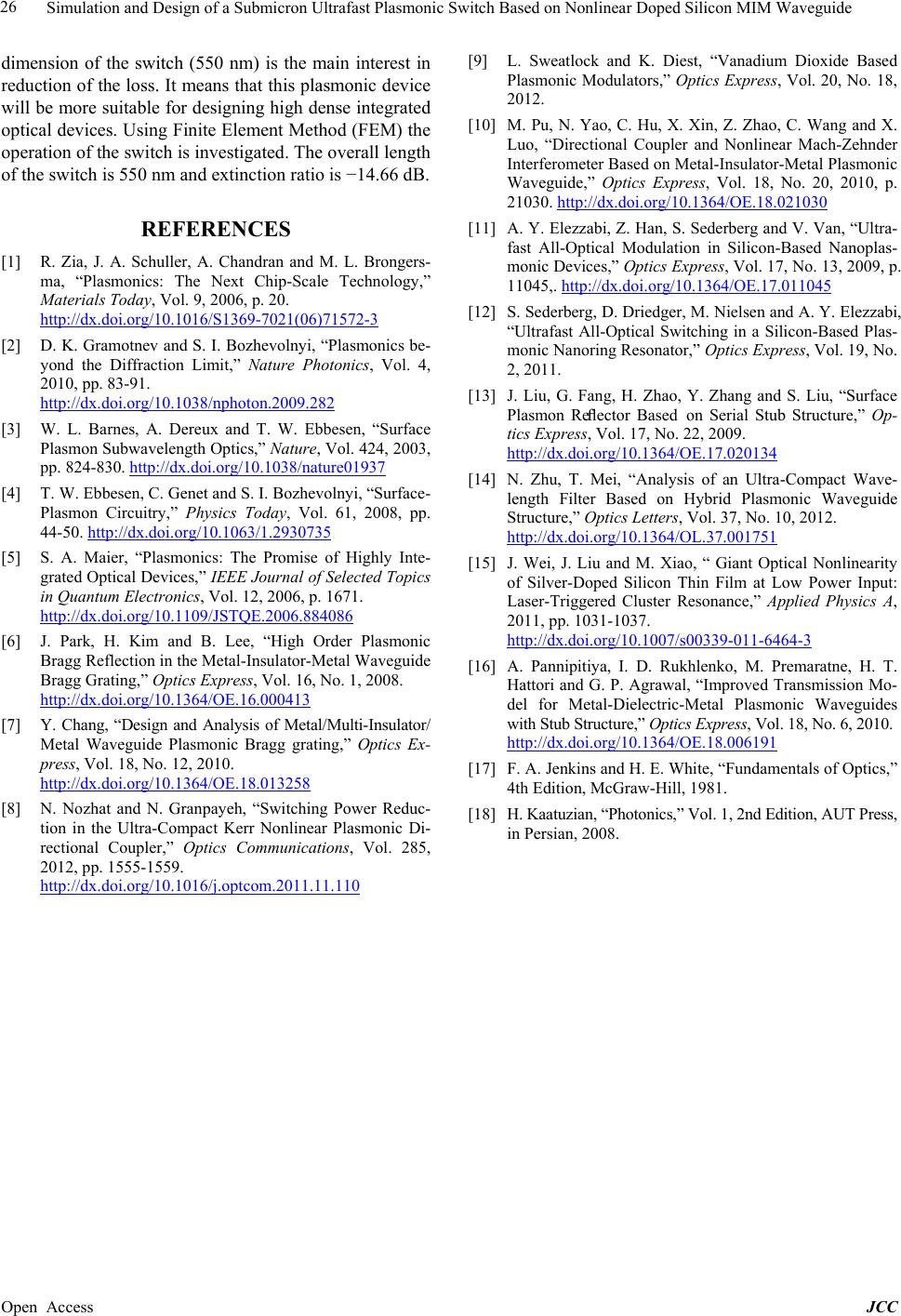
Simulation and Design of a Submicron Ultrafast Plasmonic Switch Based on Nonlinear Doped Silicon MIM Waveguide
Open Access JCC
dimension of the switch (550 nm) is the main interest in
reduction of the loss. It means that this plasmonic device
will be more suitable for designing high dense integrated
optical devices. Using F inite Element Method (FEM) the
operation of the switch is investigated. The overall length
of the switch is 550 nm and extinction ratio is −14.66 dB.
REFERENCES
[1] R. Zia, J. A. Schuller, A. Chandran and M. L. Brongers-
ma, “Plasmonics: The Next Chip-Scale Technology,”
Materials Today, Vol. 9, 2006, p. 20.
http://dx.doi.org/10.1016/S1369-7021(06)71572-3
[2] D. K. Gramotnev and S. I. Bozhevolnyi, “Plasmonics be-
yond the Diffraction Limit,” Nature Photonics, Vol. 4,
2010, pp. 83-91.
http://dx.doi.org/10.1038/nphoton.2009.282
[3] W. L. Barnes, A. Dereux and T. W. Ebbesen, “Surface
Plasmon Subwavelength Optics,” Nature, Vol. 424, 2003,
pp. 824-830. http://dx.doi.org/10.1038/nature01937
[4] T. W. Ebbesen, C. Genet and S. I. Bozhevolnyi, “Surface-
Plasmon Circuitry,” Physics Today, Vol. 61, 2008, pp.
44-50. http://dx.doi.org/10.1063/1.2930735
[5] S. A. Maier, “Plasmonics: The Promise of Highly Inte-
grated Optical Devices,” IEEE Journal of Selec ted Topics
in Quantum Electronics, Vol. 12, 2006, p. 1671.
http://dx.doi.org/10.1109/JSTQE.2006.884086
[6] J. Park, H. Kim and B. Lee, “High Order Plasmonic
Bragg Reflection in the Metal-Insulator-Metal Waveguide
Bragg Grating,” Optics Express, Vol. 16, No. 1, 2008.
http://dx.doi.org/10.1364/OE.16.000413
[7] Y. Chang, “Design and Analysis of Metal/Multi-Insulator/
Metal Waveguide Plasmonic Bragg grating,” Optics Ex-
press, Vol. 18, No. 12, 2010.
http://dx.doi.org/10.1364/OE.18.013258
[8] N. Nozhat and N. Granpayeh, “Switching Power Reduc-
tion in the Ultra-Compact Kerr Nonlinear Plasmonic Di-
rectional Coupler,” Optics Communications, Vol. 285,
2012, pp. 1555-1559.
http://dx.doi.org/10.1016/j.optcom.2011.11.110
[9] L. Sweatlock and K. Diest, “Vanadium Dioxide Based
Plasmonic Modulators,” Optics Express, Vol. 20, No. 18,
2012.
[10] M. Pu, N. Yao, C. Hu, X. Xin, Z. Zhao, C. Wang and X.
Luo, “Directional Coupler and Nonlinear Mach-Zehnder
Interferometer Based on Metal-Insulator-Metal Plasmonic
Waveguide,” Optics Express, Vol. 18, No. 20, 2010, p.
21030. http://dx.doi.org/10.1364/OE.18.021030
[11] A. Y. Elezzabi, Z. Han, S. Sederberg and V. Van, “Ultra-
fast All-Optical Modulation in Silicon-Based Nanoplas-
monic Devices,” Optics Ex press, Vol. 17, No. 13, 2009, p.
11045,. http://dx.doi.org/10.1364/OE.17.011045
[12] S. Sederberg, D. Driedger, M. Nielsen and A. Y. Elezzabi,
“Ultrafast All-Optical Switching in a Silicon-Based Plas-
monic Nanoring Resonator,” Optics Express, Vol. 19, No.
2, 2011.
[13] J. Liu, G. Fang, H. Zhao, Y. Zhang and S. Liu, “Surface
Plasmon Reflector Based on Serial Stub Structure,” Op-
tics Express , Vol. 17, No. 22, 2009.
http://dx.doi.org/10.1364/OE.17.020134
[14] N. Zhu, T. Mei, “Analysis of an Ultra-Compact Wave-
length Filter Based on Hybrid Plasmonic Waveguide
Structure,” Optics Letters, Vol. 37, No. 10, 2012.
http://dx.doi.org/10.1364/OL.37.001751
[15] J. Wei, J. Liu and M. Xiao, “ Giant Optical Nonlinearity
of Silver-Doped Silicon Thin Film at Low Power Input:
Laser-Triggered Cluster Resonance,” Applied Physics A,
2011, pp. 1031-1037.
http://dx.doi.org/10.1007/s00339-011-6464-3
[16] A. Pannipitiya, I. D. Rukhlenko, M. Premaratne, H. T.
Hattori and G. P. Agrawal, “Improved Transmission Mo-
del for Metal-Dielectric-Metal Plasmonic Waveguides
with Stub Structure,” Optics Express, Vol. 18, No. 6, 2010.
http://dx.doi.org/10.1364/OE.18.006191
[17] F. A. Jenkins and H. E. Whit e, “Fundamentals of Optics,”
4th Edition, McGraw-Hill, 1981.
[18] H. Kaat uzian, “Photonics,” Vol. 1, 2nd Edition, AUT Press,
in Persian, 2008.